NSSL researcher answers the question: "When and where
does severe weather occur?"
...continued
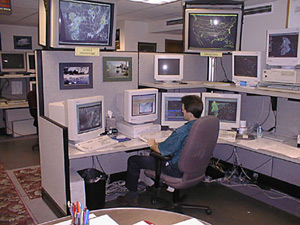
People who use the climatology come from a wide variety of places. The NOAA Storm Prediction Center uses it in determining the probabilistic forecasts of severe weather that they now make. Brooks constructed the climatology to produce numbers that helped the SPC do their job and to provide them with the background numbers they need as part of their new probabilistic forecasts.
This has also been used by people in the insurance industry, trying to come up with unbiased estimates of where things are going to be happening. Usually, the companies tend to use their past loss records, but if they start doing business in a new location, or if the population expands and they start insuring people in places where no one has ever been insured, they don't have an accurate estimate of where very severe weather can occur.
It has also been used by emergency management people to try and understand threats for local communities and what elements of severe weather they need to be concerned about. Also, it helps to inform them about the kinds of things that don't occur every year, but occur every once in a while. Brooks said the public may forget over the course of a few years that they actually may have a threat for an event. And emergency planners can prepare for events they may experience only once in their career.
National Weather Service offices locally have used the climatology for training their spotters to tell them what their threats are, where they mostly occur during the year, or if they're in a location where the threat is spread throughout an entire year. This helps local emergency officials let their spotters know what the demands are going to be, what they should be paying attention to and when it's most likely to cause them problems.
Brooks said there has been an international interest in his study of climatology and that it turned out to be more popular than he thought it would be.
"It was one of those rare moments in my scientific life where as you start to work on it, you realize you're doing something that's actually really good," Brooks said. "As scientists, we have lots of ideas and lots of things we work on and if we're honest with ourselves, a lot of the time we're like, well, this is ok and this is worth writing about, but then every once in a while you get one of those little ideas that you go 'wow, this is actually something that could be truly neat and important and it could work out well.'"
One of the biggest things that the climatology work did was that it helped in the NSSL's relationship with the SPC. This was the kind of thing that they really needed for product changes that they wanted to make. Brooks was able to produce something very quickly, in a matter of a few weeks, once they said that they wanted it.
How the NOAA Storm Prediction Center applied our work: |
||
SPC was able to take their routine outlook for severe weather (right, for 11:30 a.m. Friday, October 8, 2004 until 6 a.m. CST Saturday) and break out the specific probability of hail, tornado, and strong winds (below) using NSSL's severe weather climatology. |
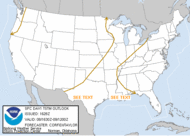 |
|
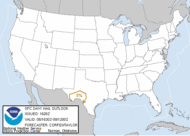
Chance of hail |
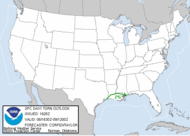
Chance of tornado |
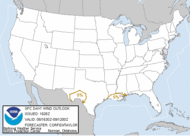
Chance of strong wind |